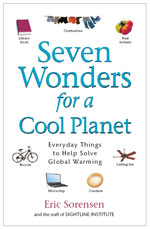The Bicycle (transportation)
- The bicycle is the most efficient vehicle ever devised. A human on a bicycle is more efficient (in calories expended per pound and per mile) than a train, truck, airplane, boat, automobile, motorcycle, or jet pack.
- Nearly half of all trips in the US are three miles or less; more than a quarter are less than a mile—distances easily covered by bike while you get fit and save money on gas.
- Every mile traveled by bike rather than by car keeps a pound of climate-damaging carbon dioxide out of the atmosphere, while reducing cash-draining stops at the pump.
- Read more bike facts here.
The Condom (population)
- Condoms are used nearly a million times a day in America.
- A 14 percent increase in the use of contraceptives could translate into 1 billion fewer births by 2050, which might spare the planet 4 billion tons of CO2 emissions each year.
- A North American uses roughly 25 times more resources over the course of her life than a resident of the developing world.
The Ceiling Fan (energy efficiency)
- Air-conditioning an average US household sends about three tons of carbon dioxide up power plant smokestacks each year.
- At the highest speed, a typical ceiling fan uses 50 to 75 watts—less than one-tenth the wattage of a medium-sized room air-conditioner.
- Because power plants typically convert only 40 percent or less of the energy in the fuel they burn to electricity, electricity saved in a home or business can save two to three times as much energy behind the scenes.
The Clothesline (renewable energy)
- If American rooftops were covered with solar shingles, they could supply half to three-quarters of the country’s present energy needs.
- Wind power is the world’s fastest-growing energy source.
- If consumers and investors had to pay for the pollution and health problems caused by fossil fuels, renewables would quickly take over the world energy market.
The Real Tomato (food production and distribution)
- More than one-fourth of Americans’ fresh fruits were imported in 2001, more than double the amount in 1985.
- A one-pound bag of lettuce—which contains a scant 80 calories of food energy—consumes as much as 4,600 calories to grow, process, and ship.
- By one calculation, the continent-spanning food distribution system emits 5 to 17 times the total carbon dioxide emissions of a local food system.
- Read more tomato facts here.
The Library Book (resource conservation and reuse)
- A typical US library prevents 250 tons of greenhouse-gas emissions each year, just from the paper it doesn’t consume.
- The average American pays $20 in taxes a year to support libraries, but saves at least twice that by borrowing half a dozen or so free books from a library instead of buying them.
- The most popular form of reuse currently may be the movie rental: video stores outnumber public libraries, and consumers rent three times as many DVDs as they buy.
The Microchip (the information economy)
- Between 1990 and 2000, the number of people working from home—also known as “teleworkers” and “people who work in their underwear”—grew by almost one-fourth.
- In Connecticut alone, telecommuting takes nearly 60,000 cars off the road every day.
- The energy costs per book sold are 16 times greater for a conventional bookstore than for Amazon or other online bookstores
See Also:
Book: Seven Wonders for a Cool Planet







